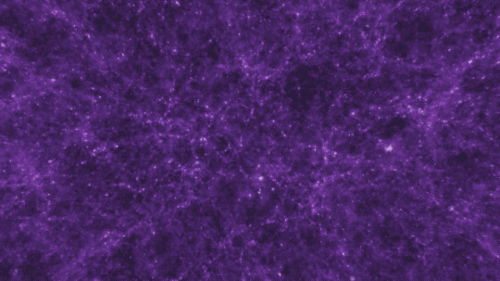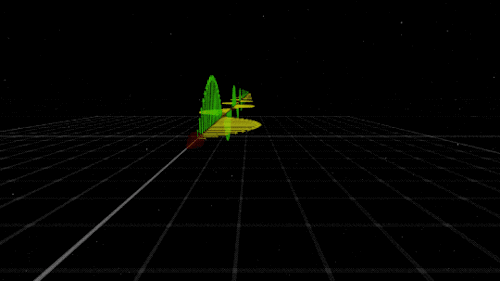A Venus Flyby Via NASA Https://ift.tt/3sv3XhX

A Venus Flyby via NASA https://ift.tt/3sv3XhX
On a mission to explore the inner heliosphere and solar corona, on July 11, 2020 the Wide-field Imager on board NASA’s Parker Solar Probe captured this stunning view of the nightside of Venus at distance of about 12,400 kilometers (7,693 miles). The spacecraft was making the third of seven gravity-assist flybys of the inner planet. The gravity-asssist flybys are designed to use the approach to Venus to help the probe alter its orbit to ultimately come within 6 million kilometers (4 million miles) of the solar surface in late 2025. A surprising image, the side-looking camera seems to peer through the clouds to show a dark feature near the center known as Aphrodite Terra, the largest highland region on the Venusian surface. The bright rim at the edge of the planet is nightglow likely emitted by excited oxygen atoms recombining into molecules in the upper reaches of the atmosphere. Bright streaks and blemishes throughout the image are likely due to energetic charged particles, and dust near the camera reflecting sunlight. Skygazers from planet Earth probably recognize the familiar stars of Orion’s belt and sword at lower right.
(Published February 25, 2021)
More Posts from Dangerous-space and Others
Perseverance Rover’s Descent and Touchdown on Mars (Official NASA Video)
This is beyond amazing.










Digital Spacescapes by Tim Barton

NGC 7023, Iris Nebula

May the Four Forces Be With You!
May the force be with you? Much to learn you still have, padawan. In our universe it would be more appropriate to say, “May the four forces be with you.”

There are four fundamental forces that bind our universe and its building blocks together. Two of them are easy to spot — gravity keeps your feet on the ground while electromagnetism keeps your devices running. The other two are a little harder to see directly in everyday life, but without them, our universe would look a lot different!
Let’s explore these forces in a little more detail.
Gravity: Bringing the universe together

If you jump up, gravity brings you back down to Earth. It also keeps the solar system together … and our galaxy, and our local group of galaxies and our supercluster of galaxies.
Gravity pulls everything together. Everything, from the bright centers of the universe to the planets farthest from them. In fact, you (yes, you!) even exert a gravitational force on a galaxy far, far away. A tiny gravitational force, but a force nonetheless.

Credit: NASA and the Advanced Visualization Laboratory at the National Center for Supercomputing and B. O'Shea, M. Norman
Despite its well-known reputation, gravity is actually the weakest of the four forces. Its strength increases with the mass of the two objects involved. And its range is infinite, but the strength drops off as the square of the distance. If you and a friend measured your gravitational tug on each other and then doubled the distance between you, your new gravitational attraction would just be a quarter of what it was. So, you have to be really close together, or really big, or both, to exert a lot of gravity.
Even so, because its range is infinite, gravity is responsible for the formation of the largest structures in our universe! Planetary systems, galaxies and clusters of galaxies all formed because gravity brought them together.
Gravity truly surrounds us and binds us together.
Electromagnetism: Lighting the way

You know that shock you get on a dry day after shuffling across the carpet? The electricity that powers your television? The light that illuminates your room on a dark night? Those are all the work of electromagnetism. As the name implies, electromagnetism is the force that includes both electricity and magnetism.
Electromagnetism keeps electrons orbiting the nucleus at the center of atoms and allows chemical compounds to form (you know, the stuff that makes up us and everything around us). Electromagnetic waves are also known as light. Once started, an electromagnetic wave will travel at the speed of light until it interacts with something (like your eye) — so it will be there to light up the dark places.

Like gravity, electromagnetism works at infinite distances. And, also like gravity, the electromagnetic force between two objects falls as the square of their distance. However, unlike gravity, electromagnetism doesn’t just attract. Whether it attracts or repels depends on the electric charge of the objects involved. Two negative charges or two positive charges repel each other; one of each, and they attract each other. Plus. Minus. A balance.
This is what happens with common household magnets. If you hold them with the same “poles” together, they resist each other. On the other hand, if you hold a magnet with opposite poles together — snap! — they’ll attract each other.
Electromagnetism might just explain the relationship between a certain scruffy-looking nerf-herder and a princess.
Strong Force: Building the building blocks

Credit: Lawrence Livermore National Laboratory
The strong force is where things get really small. So small, that you can’t see it at work directly. But don’t let your eyes deceive you. Despite acting only on short distances, the strong force holds together the building blocks of the atoms, which are, in turn, the building blocks of everything we see around us.
Like gravity, the strong force always attracts, but that’s really where their similarities end. As the name implies, the force is strong with the strong force. It is the strongest of the four forces. It brings together protons and neutrons to form the nucleus of atoms — it has to be stronger than electromagnetism to do it, since all those protons are positively charged. But not only that, the strong force holds together the quarks — even tinier particles — to form those very protons and neutrons.
However, the strong force only works on very, very, very small distances. How small? About the scale of a medium-sized atom’s nucleus. For those of you who like the numbers, that’s about 10-15 meters, or 0.000000000000001 meters. That’s about a hundred billion times smaller than the width of a human hair! Whew.
Its tiny scale is why you don’t directly see the strong force in your day-to-day life. Judge a force by its physical size, do you?
Weak Force: Keeping us in sunshine

If you thought it was hard to see the strong force, the weak force works on even smaller scales — 1,000 times smaller. But it, too, is extremely important for life as we know it. In fact, the weak force plays a key role in keeping our Sun shining.
But what does the weak force do? Well … that requires getting a little into the weeds of particle physics. Here goes nothing! We mentioned quarks earlier — these are tiny particles that, among other things, make up protons and neutrons. There are six types of quarks, but the two that make up protons and neutrons are called up and down quarks. The weak force changes one quark type into another. This causes neutrons to decay into protons (or the other way around) while releasing electrons and ghostly particles called neutrinos.
So for example, the weak force can turn a down quark in a neutron into an up quark, which will turn that neutron into a proton. If that neutron is in an atom’s nucleus, the electric charge of the nucleus changes. That tiny change turns the atom into a different element! Such reactions are happening all the time in our Sun, giving it the energy to shine.
The weak force might just help to keep you in the (sun)light.

All four of these forces run strong in the universe. They flow between all things and keep our universe in balance. Without them, we’d be doomed. But these forces will be with you. Always.
You can learn more about gravity from NASA’s Space Place and follow NASAUniverse on Twitter or Facebook to learn about some of the cool cosmic objects we study with light.
Make sure to follow us on Tumblr for your regular dose of space: http://nasa.tumblr.com

Crescent Mars




NASA and SpaceX launch astronauts Robert Behnken and Douglas Hurley to the International Space Station. [May 30th, 2020]


NGC 253: The Silver Coin Galaxy via NASA https://ift.tt/2yYJ2NM
NGC 253 is one of the brightest spiral galaxies visible, but also one of the dustiest. Dubbed the Silver Coin for its appearance in smalltelescopes, it is more formally known as the Sculptor Galaxy for its location within the boundaries of the southern constellation Sculptor. Discovered in 1783 by mathematician and astronomer Caroline Herschel, the dusty island universe lies a mere 10 million light-years away. About 70 thousand light-years across, NGC 253, pictured, is the largest member of the Sculptor Group of Galaxies, the nearest to our own Local Group of galaxies. In addition to its spiral dust lanes, tendrils of dust seem to be rising from a galactic disk laced with young star clusters and star forming regions in this sharp color image. The high dust content accompanies frantic star formation, earning NGC 253 the designation of a starburst galaxy. NGC 253 is also known to be a strong source of high-energy x-rays and gamma rays, likely due to massive black holes near the galaxy’s center. Take a trip through extragalactic space in this short video flyby of NGC 253.
(Published April 14, 2020)
Science in space

This week on NASA Explorers, we’re aboard the International Space Station!

Now that our scientists’ experiment has made it to space, it’s time to see how their samples behave in microgravity.

See how astronauts conduct science in space, while a team back here on Earth conducts their own piece of the project. Watch the episode here:
Follow NASA Explorers on Facebook to catch new episodes of season 4 every Wednesday!
Make sure to follow us on Tumblr for your regular dose of space: http://nasa.tumblr.com
-
 spacebraincreatures reblogged this · 1 year ago
spacebraincreatures reblogged this · 1 year ago -
 thelacey reblogged this · 3 years ago
thelacey reblogged this · 3 years ago -
 thelacey liked this · 3 years ago
thelacey liked this · 3 years ago -
 wakayume liked this · 4 years ago
wakayume liked this · 4 years ago -
 11g liked this · 4 years ago
11g liked this · 4 years ago -
 eleven-bees-in-a-trenchcoat liked this · 4 years ago
eleven-bees-in-a-trenchcoat liked this · 4 years ago -
 snow280 liked this · 4 years ago
snow280 liked this · 4 years ago -
 shortmage reblogged this · 4 years ago
shortmage reblogged this · 4 years ago -
 sadass24 liked this · 4 years ago
sadass24 liked this · 4 years ago -
 fireskywalkr liked this · 4 years ago
fireskywalkr liked this · 4 years ago -
 coolexplorer liked this · 4 years ago
coolexplorer liked this · 4 years ago -
 preem79 liked this · 4 years ago
preem79 liked this · 4 years ago -
 dangerous-space reblogged this · 4 years ago
dangerous-space reblogged this · 4 years ago -
 dangerous-space reblogged this · 4 years ago
dangerous-space reblogged this · 4 years ago -
 dangerous-space liked this · 4 years ago
dangerous-space liked this · 4 years ago -
 svenskadata liked this · 4 years ago
svenskadata liked this · 4 years ago -
 sciencemuser-andgirl reblogged this · 4 years ago
sciencemuser-andgirl reblogged this · 4 years ago -
 dorklesblog liked this · 4 years ago
dorklesblog liked this · 4 years ago -
 marcus-felipe liked this · 4 years ago
marcus-felipe liked this · 4 years ago -
 daethea liked this · 4 years ago
daethea liked this · 4 years ago -
 cassandra-pentughasst reblogged this · 4 years ago
cassandra-pentughasst reblogged this · 4 years ago -
 derryhawkins reblogged this · 4 years ago
derryhawkins reblogged this · 4 years ago -
 c-maxisgr reblogged this · 4 years ago
c-maxisgr reblogged this · 4 years ago -
 supermassivespacebabe reblogged this · 4 years ago
supermassivespacebabe reblogged this · 4 years ago -
 jbatispte liked this · 4 years ago
jbatispte liked this · 4 years ago -
 calloutnevvegas reblogged this · 4 years ago
calloutnevvegas reblogged this · 4 years ago -
 calloutnevvegas liked this · 4 years ago
calloutnevvegas liked this · 4 years ago -
 thoughtfulranchneckprune-blog liked this · 4 years ago
thoughtfulranchneckprune-blog liked this · 4 years ago -
 zannin-witaslight-lean reblogged this · 4 years ago
zannin-witaslight-lean reblogged this · 4 years ago -
 jimmybear13 liked this · 4 years ago
jimmybear13 liked this · 4 years ago -
 nmcatmom liked this · 4 years ago
nmcatmom liked this · 4 years ago -
 humongousbasementnerd liked this · 4 years ago
humongousbasementnerd liked this · 4 years ago -
 johnnydirt808 liked this · 4 years ago
johnnydirt808 liked this · 4 years ago -
 potterpenguins liked this · 4 years ago
potterpenguins liked this · 4 years ago -
 charlesh55 liked this · 4 years ago
charlesh55 liked this · 4 years ago -
 rosecoloredrenee liked this · 4 years ago
rosecoloredrenee liked this · 4 years ago -
 shavothehusky reblogged this · 4 years ago
shavothehusky reblogged this · 4 years ago -
 shavothehusky liked this · 4 years ago
shavothehusky liked this · 4 years ago -
 whereproductivitygoestodie reblogged this · 4 years ago
whereproductivitygoestodie reblogged this · 4 years ago -
 emoteddylove21-blog liked this · 4 years ago
emoteddylove21-blog liked this · 4 years ago -
 palewonderlandenemy liked this · 4 years ago
palewonderlandenemy liked this · 4 years ago -
 stickyhunter liked this · 4 years ago
stickyhunter liked this · 4 years ago -
 zippy6958 liked this · 4 years ago
zippy6958 liked this · 4 years ago -
 engelart liked this · 4 years ago
engelart liked this · 4 years ago -
 felixarborius liked this · 4 years ago
felixarborius liked this · 4 years ago -
 herexistencealone liked this · 4 years ago
herexistencealone liked this · 4 years ago -
 gayingupspace reblogged this · 4 years ago
gayingupspace reblogged this · 4 years ago

22 year old space blogger•Not just a space blogger.Also a worrier. •
75 posts